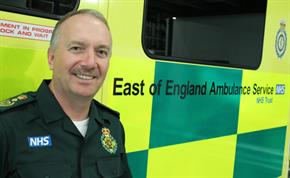
A few weeks ago I talked about the pressure facing our patient-facing staff with the increasing numbers of 999 calls, especially red calls. This, coupled with some of the policies that have been put into place, has stretched our capacity and put pressure on both EOC and those clinicians on the road.
When I met with MPs a couple of weeks ago, I talked to them about this pressure on our service and staff. Demand, coupled with arbitrary time response targets, has resulted in people being increasingly asked to deliver every second and every minute, constantly moving from one patient or caller with no chance to catch their breath, reflect and reset themselves. It also means that we have no flexibility or spare capacity to respond to peaks in demand.
Whilst we can’t change the time response targets ourselves – this will need to be agreed at a national and government level – we can look at how we manage demand and how we respond to calls. I have heard a lot about the ambulance service receiving inappropriate calls; personally I don’t believe that any 999 call is inappropriate, the patient is always right! However, the way in which we respond to many calls is clearly inappropriate and that is what we need to manage much, much better.
We have started working on how to better handle that demand and ensure we provide the appropriate response to patients more often. We are recruiting more clinical co-ordinators into our EOCs so that we can increase the number of patients we can treat or advise over the phone.
We are also running a trial, whereby we have a GP in Norwich EOC at peak times. The GP can give advice to crews on treatment and appropriate care pathways, and in future will also be able to talk to and treat less serious patients over the phone. The early results are very encouraging – so far in almost 80% of cases, an alternative and more appropriate pathway has been found for the patient, thus avoiding the need to go into an emergency department. Over last weekend, our GPs took their 450th call in EOC!
We are also considering how we implement enhanced clinical triage for 999 calls. However we need to do this very carefully, learning from the mistakes of the past, with the appropriate clinical staff involved and the right clinical governance in place, to ensure it is safe for patients. This is an approach that is actively supported by our commissioners.
We have also raised the issue of Red 111 calls with our commissioners, who have responded positively by requesting that 111 providers implement GP-led triage of calls before they are passed to us. We are just starting to see the positive impact of this change. We’re also in discussions about general 111 referrals into our service; we know this is a national issue and one that needs to be managed carefully, but one that can have a massive impact on our demand and collectively how we better manage patients. I will keep you posted on developments.
On a similar line, the International Academy that manages the triage system we use is currently carrying out a study into those patients who present over the phone as ‘NOT ALERT’. I have heard from so many of you that this is a major issue and a cause for a high volume of calls, which should not be prioritised as red calls. The current study is collecting data and the next stage will be to look at trialling different questions, which will be led by London Ambulance Service - while clinicians might understand a question about consciousness, the majority of 999 callers would not. But to be very clear, we cannot, due to the medical licensure surrounding our triage system, change any of the script without appropriate external approval.
Last week I also met with the Chair and Chief Executive at the Norfolk and Norwich Hospital to discuss handover delays and conveyance rates amongst other things. We had a very productive meeting where we explored how each organisation can help each other, reduce the pressure on both services and in turn provide a better service to patients. We also discussed the potential for alternative care pathways and how our ECPs could be part of a solution to increase the numbers of patients whom are seen in their minor injuries unit if it were transitioned to an urgent care centre.
All signs that we are, together, moving in the right direction. Thank you for your hard work and have a good week.
With best wishes,
Robert
Published 29th October, 2015